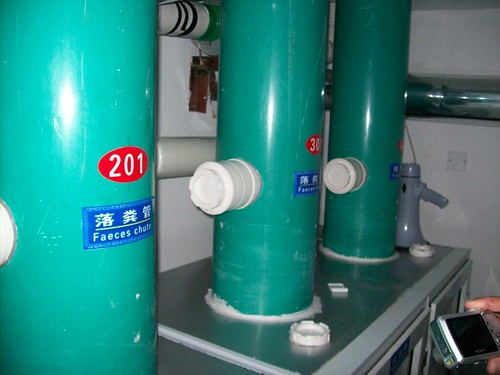- Forum
- categories
- Sanitation systems
- Toilets with urine diversion
- UDDTs (urine-diverting dry toilets)
- UDDTs at schools (urine-diverting dry toilets)
- Successful experiences on a good working service for UDDT / Ecosan system in urban area?
Successful experiences on a good working service for UDDT / Ecosan system in urban area?
15.8k views
Dear Florent, dear all,
in addition to my last post I send annexed a publication on the subject of composting toilets in urban settings. In recent years, some of our TerraNova toilets were supplemented with inserts for urine separation. Not all residents wanted this. The settlement exists now for more than 20 years, has about 300 inhabitants and is probably the largest settlement with composting toilets (70 containers) worldwide. What was new at this time was the installation of composting toilets in four-story buildings. Along with 2 universities we had applied for a research project, which was unfortunately rejected. Composting toilets need more research and development, so that it remains not only in single functioning projects or projects that have failed.
Best regards
Wolfgang
in addition to my last post I send annexed a publication on the subject of composting toilets in urban settings. In recent years, some of our TerraNova toilets were supplemented with inserts for urine separation. Not all residents wanted this. The settlement exists now for more than 20 years, has about 300 inhabitants and is probably the largest settlement with composting toilets (70 containers) worldwide. What was new at this time was the installation of composting toilets in four-story buildings. Along with 2 universities we had applied for a research project, which was unfortunately rejected. Composting toilets need more research and development, so that it remains not only in single functioning projects or projects that have failed.
Best regards
Wolfgang
Wolfgang Berger
BERGER BIOTECHNIK GmbH
Hedenholz 6
24113 Kiel, Germany
tel. +49(0)1724337875
This email address is being protected from spambots. You need JavaScript enabled to view it.
www.berger-biotechnik.de
BERGER BIOTECHNIK GmbH
Hedenholz 6
24113 Kiel, Germany
tel. +49(0)1724337875
This email address is being protected from spambots. You need JavaScript enabled to view it.
www.berger-biotechnik.de
This message has an attachment file.
Please log in or register to see it.
Please Log in to join the conversation.
You need to login to reply- Elisabeth
-
- User is blocked
- Freelance consultant since 2012
Less- Posts: 3372
- Karma: 54
- Likes received: 932
Re: Why did the World's biggest eco-toilet scheme fail?
Dear Florent,
Could you better define "urban" here? E.g. in Lima there are UDDTs (about 600 of them; urine not collected but infiltrated) built by Rotaria, but perhaps those areas would be called "peri-urban". Does urban automatically mean multi-storey buildings?
As you posted in this thread on the Erdos Eco-Town project in China, I would like to point out to people that I recently synthesised the information about why this project failed for the Wikipedia article on UDDTs, please see here:
en.wikipedia.org/wiki/Urine-diverting_dr...ulti-story_buildings
This is what we (Kai, Arno, Amparo, myself) wrote there:
+++++++
Urban multi-story buildings [edit source | edit]
UDDTs with combined ventilation and collection systems can also be installed in urban multi-story buildings but only one successful example of such a design exists: the Gebers collective housing estate in Orhem, Sweden.[8]
Example of Erdos Eco-Town Project, China [edit source | edit]
A much larger-scale installation which portrays the need to adhere to minimum design and installation standards existed in a project called the "Erdos Eco-Town Project" in Erdos located in the Inner Mongolia Autonomous Region of China.[9][10][11] The project was implemented during 2003-2009. This urban installation for 3000 residents in multi-story buildings utilized UDDTs that shared ventilation and urine collection pipework and made use of chutes that extended down into basements for the collection of feces. The UDDT system was accompanied by greywater treatment facilities, solid waste composting and the reuse of these materials as a fertilizer in agriculture.
However, due to several problems related to improper design and installation, the lack of a cohesive plan to address these deficiencies and the resulting resident objections, the UDDTs were replaced by conventional flush toilets in 2009. The main reasons for why these UDDTs were replaced with flush toilets were:[10]
If these lessons are taken into consideration, future large-scale UDDT installations in urban areas could succeed.[10]
 Faeces collection
by
SuSanA Secretariat
, on Flickr
Faeces collection
by
SuSanA Secretariat
, on Flickr
+++++++
(As usual, I invite anyone to improve the content about urban UDDTs directly on Wikipedia, or to give feedback here.)
Elisabeth
Could you better define "urban" here? E.g. in Lima there are UDDTs (about 600 of them; urine not collected but infiltrated) built by Rotaria, but perhaps those areas would be called "peri-urban". Does urban automatically mean multi-storey buildings?
As you posted in this thread on the Erdos Eco-Town project in China, I would like to point out to people that I recently synthesised the information about why this project failed for the Wikipedia article on UDDTs, please see here:
en.wikipedia.org/wiki/Urine-diverting_dr...ulti-story_buildings
This is what we (Kai, Arno, Amparo, myself) wrote there:
+++++++
Urban multi-story buildings [edit source | edit]
UDDTs with combined ventilation and collection systems can also be installed in urban multi-story buildings but only one successful example of such a design exists: the Gebers collective housing estate in Orhem, Sweden.[8]
Example of Erdos Eco-Town Project, China [edit source | edit]
A much larger-scale installation which portrays the need to adhere to minimum design and installation standards existed in a project called the "Erdos Eco-Town Project" in Erdos located in the Inner Mongolia Autonomous Region of China.[9][10][11] The project was implemented during 2003-2009. This urban installation for 3000 residents in multi-story buildings utilized UDDTs that shared ventilation and urine collection pipework and made use of chutes that extended down into basements for the collection of feces. The UDDT system was accompanied by greywater treatment facilities, solid waste composting and the reuse of these materials as a fertilizer in agriculture.
However, due to several problems related to improper design and installation, the lack of a cohesive plan to address these deficiencies and the resulting resident objections, the UDDTs were replaced by conventional flush toilets in 2009. The main reasons for why these UDDTs were replaced with flush toilets were:[10]
- Odor problems in the apartments produced serious objections amongst residents. Designing a properly working ventilation system for an extensive network of piping (urine pipes, ventilation pipes, fecal chutes) and accounting for factors such as high winds, open bathroom windows, and kitchen exhaust fans, required relatively complex engineering. Frozen ventilation pipes during the extremely cold winters of 2007 and 2008 caused odors from the feces bins to back up into the apartments contributing further to residents' displeasure.
- In such a large-scale UDDT system the plumbing pipework for the urine pipes and the ventilation system demand a relatively high level of engineering and construction, a standard not met by the builders.
- The standard of living in the Erdos area rose dramatically during the project time period. Also, water shortage (which had been a driver for dry toilets) was no longer regarded as a problem since a pipeline was built to the Yellow River and deeper fossil water resources were extracted. Many residents viewed flush-toilets as the "gold-standard" in sanitation and dry toilets were considered as backward in a modern urban setting.
- A stakeholder education approach among residents focused on early participation and learning about the use and maintenance of the UDDTs was not possible since the residents arrived on the scene only after the apartments were already built. They also had no choice in deciding on the kind of toilet that they wanted to have.
- There was a lack of dedicated owners who felt responsible for solving maintenance issues. Once the design problems were identified, residents balked at covering the costs necessary to correct the problems with the existing system, particularly given their distrust of it. So, needing to resolve the issue quickly, the District Governor responded by investing in flush toilets instead.
If these lessons are taken into consideration, future large-scale UDDT installations in urban areas could succeed.[10]

+++++++
(As usual, I invite anyone to improve the content about urban UDDTs directly on Wikipedia, or to give feedback here.)
Elisabeth
Dr. Elisabeth von Muench
Freelance consultant on environmental and climate projects
Freelance consultant on environmental and climate projects
Please Log in to join the conversation.
You need to login to reply- Florent
-
 Topic Author
Topic Author- sustainable sanitation study project manager
Less- Posts: 37
- Karma: 1
- Likes received: 6
Successful experiences on a good working service for UDDT / Ecosan system in urban area?
Note by moderator: This post was originally here, hence the second post referring to the Erdos Eco-Town project:
forum.susana.org/forum/categories/173-ur...inner-mongolia-china
+++++++++++++
Hello,
I just read posts relating to this subject. I'm looking for an successfull experience on a good working service for UDDT / Ecosan system in urban area. The Ecosan used are mostly autonomous system (situated near the house) and the services must realised emptying pit and litter supply or other carbon material.
Thanks for your feedback
forum.susana.org/forum/categories/173-ur...inner-mongolia-china
+++++++++++++
Hello,
I just read posts relating to this subject. I'm looking for an successfull experience on a good working service for UDDT / Ecosan system in urban area. The Ecosan used are mostly autonomous system (situated near the house) and the services must realised emptying pit and litter supply or other carbon material.
Thanks for your feedback
Please Log in to join the conversation.
You need to login to reply
Share this thread:
- Forum
- categories
- Sanitation systems
- Toilets with urine diversion
- UDDTs (urine-diverting dry toilets)
- UDDTs at schools (urine-diverting dry toilets)
- Successful experiences on a good working service for UDDT / Ecosan system in urban area?
Recently active users. Who else has been active?
Time to create page: 0.078 seconds







